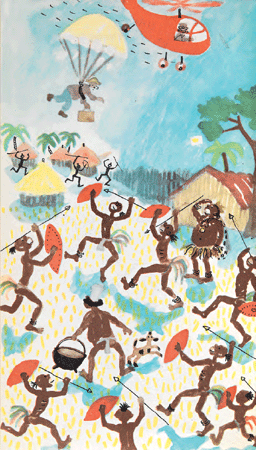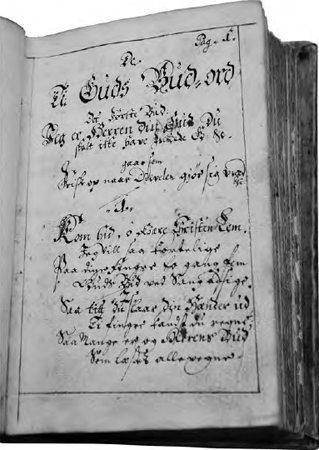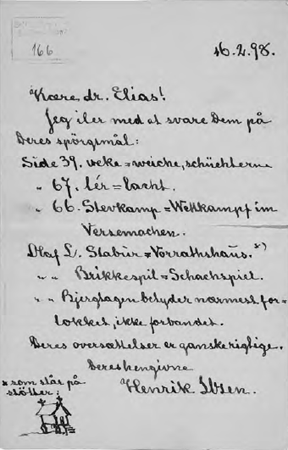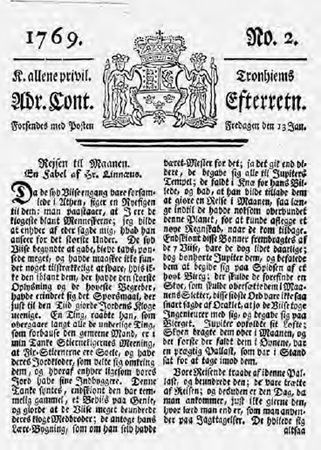Jaarboek voor Nederlandse Boekgeschiedenis. Jaargang 20
(2013)– [tijdschrift] Jaarboek voor Nederlandse Boekgeschiedenis–
[pagina 140]
| |
 Figure 1. Should racism be purged from new editions of classic children's books? Image from a song book by Norway's most beloved children's author, composer and illustrator, Torbjørn Egner (1951). Photo: Koninklijke Bibliotheek, The Hague. See pages 149-150
| |
[pagina 141]
| |
Aina Nøding
| |
[pagina 142]
| |
Book collections, library history and bibliographyUnlike major European countries, Norway has few old and special book collections or libraries. Even so, some book collections have come into the fore in Norwegian book history in recent years. A very thorough and informative contribution in that respect is Gina Dahl's Books in Early Modern Norway (2011).Ga naar voetnoot4 In this work, Dahl (University of Bergen) traces the dissemination of books in the seventeenth and eighteenth centuries mainly by analysing book inventories and catalogues of private collections. Even with the limitations such an approach presents her with, it still produces a surprising image of Norwegian readers as fully integrated in the European book market of the time, including most learned professions, as well as readers of popular literature. What the picture will look like for the nineteenth century remains to be seen. Elisabeth Eide (The National Library) is currently writing a book on private book collections and reading societies in the nineteenth century.Ga naar voetnoot5 Her articles published so far on the subject cover reading societies and private book collections of both farmers and higher officials. She discusses book ownership and reading in all social layers of society, and shows there were marked differences in tastes: mainly religious reading among peasants, entertaining novels among the bourgeoisie, and theology, law and history among the officials.Ga naar voetnoot6 Library history was also the topic of an anthology published by The National Library in 2011, containing articles on libraries and book collections in Norway over the past 200 years. The main focus of this collection is the history of major public and university libraries of Norway.Ga naar voetnoot7 The National Library has been the core institution for organising a steady flow of author jubilees in recent years. It started with a massive celebration of the centennial of the playwright Henrik Ibsen's death in 2006, and was followed by the anniversaries of, among others, the Nobel laureates Sigrid Undset (2007), Knut Hamsun (2009), and Bjørnstjerne Bjørnson (2010), as well as the contemporary author Dag Solstad (2011). An important part of these celebrations was the production of bibliographies, led by The National Library. In keeping with the times, these bibliographies are available online only.Ga naar voetnoot8 In the case of Ibsen, the bibliography includes both his production and (printed) | |
[pagina 143]
| |
reception. The bibliographies have proved helpful for and popular with the general public, students and scholars at home and abroad. As well as being important steps in collecting and organising information about important authors, they have also been instrumental in promoting these authors to a larger audience. | |
History of reading and literacyDespite a lack of tradition of major libraries or book collections, Norway has a great tradition of reading and (as the bibliographies suggest) of writing. This could explain the academic focus on literacy, reading practices and the book market, rather than on the material book, in Norwegian book history. Partly due to the nation's Lutheran and pietistic traditions, after the Reformation reading was regarded as essential to all subjects of the Dano-Norwegian king. As the Danish scholar Charlotte Appel has shown in her major work on reading in Denmark in the seventeenth century, literacy was widespread, even among lower social classes of society.Ga naar voetnoot9 This was further enhanced with the pietistic king Christian vi's school law of 1739, which made learning to read compulsory for everyone, in order for children to pass their confirmation. That reading was widespread in Norway too, was documented by Jostein Fet in his detailed study of reading among Norwegian peasants before 1840, including inventories of peasants' privately owned books (1995).Ga naar voetnoot10 That writing, as well as reading, was a more common skill among ordinary people than had been acknowledged before was the conclusion of his next study (2003).Ga naar voetnoot11 While he estimates that in the eighteenth century about 80-90% of the population could read to some extent, only 20-30% of the population could write. Fet's findings marked a shift in how historical literacy rates are estimated and his findings have informed more recent studies in this area. Among them is Lis Byberg's PhD dissertation (University College of Oslo and Akershus) on book auctions in Norway between 1750 and 1815 (2007).Ga naar voetnoot12 She concludes that members from all parts of society bought a broad spectre of books at these auctions, and that the reading community was indeed much larger and more diverse than previously assumed. So, if this was the case, how did people acquire their reading skills, and how, where and by whom were people taught to read? Dagrun Skjelbred's (University College of Vestfold) most recent book (2010) traces how reading and writing was taught in Norwegian schools from the eighteenth century to this day.Ga naar voetnoot13 In her study, the material book (abc books and readers) play an important role in uncovering teaching methods. By analysing the typography, | |
[pagina 144]
| |
illustrations and formats, as well as content, the books reveal how teaching methodologies changed through history. From the Reformation onwards, reading for religious purposes was the most important factor in the increase of popular reading in Norway. In his work on the critical edition of the CathecismesangeGa naar voetnoot14 by the seventeenth-century national bard, the vicar Petter Dass from northern Norway, Jon Haarberg (University of Oslo) was intrigued by the close link between religious songs, teaching, catechisms and reading. His work in this field runs parallel to the work of Charlotte Appel. Working on material from the Norwegian seventeenth century also means studying the textual interchange between manuscripts, transcripts and printed texts, as Dass' work was never printed in his lifetime, partly due to his geographical position in the periphery of the periphery. An intimate knowledge of the material book, book market, transport and technology is indispensable for anyone working within textual criticism, perhaps particularly with texts of this time and place.  Figure 2. Adolph Tidemand, Followers of Hans Nielsen Hauge (1856). Hauge's lay religious movement encouraged extensive reading, writing and printing among Norwegian peasants in the early nineteenth century. Oslo, Nasjonalmuseet
| |
[pagina 145]
| |
 Figure 3. The oldest surviving manuscript of Dass' Cathecismesange (1698), discovered by Jon Haarberg in 2003. Photo: the Peter Dass Museum
In this scholarly crossroads of book history, religion and literacy we also find Trygve Riiser Gundersen (University of Oslo). He is currently writing his PhD thesis on the religious dissident and lay preacher Hans Nielsen Hauge (1771-1824). Hauge wrote and published large numbers of religious tracts and books, which helped form a major religious layman's movement in southern Norway. One of Riiser Gundersen's main points is that the print runs of his texts, totalling hundreds of thousands of copies in a country with less than a million citizens, themselves bear witness to the extent of popular reading and literacy in the eighteenth and early nineteenth centuries. Lay religion became a new arena where ordinary people could write and publish despite being severely frowned upon, and even persecuted, by the authorities. A parallel phenomenon in Denmark was the pietistic Herrnhuts (the Moravian church), where members' reading and writing became core activities of the movement. | |
[pagina 146]
| |
The book market and reception studiesThe histories of book collections and reading are closely related to studies of the book market. A history of the Norwegian book trade was published in four volumes by Harald L. and Egil Tveterås (1936-1996)Ga naar voetnoot15 and in addition, some major publishing houses have had their histories published.Ga naar voetnoot16 In recent years the interest in this area has turned to the relationship between the Norwegian and the international market, particularly in the nineteenth century, when the book market was largely a common Dano-Norwegian market. For historical reasons, written Norwegian was very similar to Danish, so books published in Denmark were also sold on the Norwegian market (although not vice versa). During the second half of the century, major authors like Henrik Ibsen, Bjørnstjerne Bjørnson and Knut Hamsun all published their books with Gyldendal in Copenhagen, who distributed them to Danish and Norwegian book stores alike. The historian Narve Fulsås (University of Tromsø), working on the publishing history of Henrik Ibsen's works, was astonished to find that the relatively small book markets of Denmark and Norway could provide authors like Ibsen and Bjørnson with a very comfortable living, even compared to major European authors of the time.Ga naar voetnoot17 It is also remarkable how, over a few decades, the work of a number of Scandinavian authors became world literature. When Ibsen became an internationally renowned author, and sold millions of copies of his dramas in Germany alone, it was still the home market that provided him with his core income. The reasons for that were partly international copyright laws, partly a difference between the home market (mainly bound books) and continental market (cheap paperback editions). A new research project led by Narve Fulsas is currently further investigating these findings and the structure of the international European book market in the nineteenth century.Ga naar voetnoot18 A project related to this thematically was Giuliano D'Amico's PhD dissertation (University of Oslo, 2011) on Ibsen's early reception in Italy.Ga naar voetnoot19 As Ibsen's plays were imported into Italy by way of Germany, D'Amico's research included an attempt to trace the written and unwritten laws of the international European book market in late nineteenth century. In addition, Tore Rem published a book on Ibsen's reception in England | |
[pagina 147]
| |
(2006).Ga naar voetnoot20 While this study is mainly a mapping of Ibsen's critical reception, Rem is now preparing a study of how Ibsen was published and promoted in England. A Dickens scholar, Rem has also published studies of Dickens' groundbreaking methods in publishing his novels in serials and promoting them to the public, as well as working on the reception of Dickens' work in Norway.Ga naar voetnoot21 Rem's earlier publications include a book on the Norwegian author Alexander L. Kielland and the way he established himself early on as a classic on the book market by being very conscious of how the material aspects of a book convey meaning.Ga naar voetnoot22  Figure 4. Letter from Ibsen to his German translator Julius Elias. Ibsen took an active part in regulating the publications and translations of his dramas in Europe. Photo: University of Oslo
The link between (international) reception and book market was also the topic for my own study of Norwegian editions of James Fenimore Cooper's The Last of the | |
[pagina 148]
| |
Mohicans between 1826 and 1998 (2001). The development of the 300-page romantic epic turned children's book reflected not just the changed literary status of Cooper. It also reflected changes in literary tastes, local politics, structural developments in the book market and its groups of readers, and how the text and its presentation were shaped in keeping with the shifting trends.  Figure 5. ‘A Journey to the Moon, a fable’, attributed to Carl von Linné, printed 1769 in the intelligencer Adresseavisen in Trondheim. The fable journeyed from a Latin dissertation in Sweden, across Europe and North America by way of periodicals, returning to Scandinavia as a satire on academic life. Photo: the National Library of Norway
The relationship between book market, reception and international circulation of texts continue to be the topics for my recent and current studies, looking at the intersection of literature and the press. My dissertation (2007) on literature published in the first Norwegian newspapers (of the 1760s) presented a broad range of texts published in these papers, originating from Persia to America. They included everything from classical to contemporary poems, or fables by Lessing to parts of novels by Voltaire. In my current project on eighteenth-century journals in the twin kingdom of Denmark-Norway, a main issue is the importance of the journal as a medium for the dissemination and circulation of literary texts and Enlightenment ideas. It was an important supplement | |
[pagina 149]
| |
and to some extent efficient competitor to the book. Both studies stress the close relationship between book and periodical, in terms of texts, personnel, economy and technology, concluding that particularly in the eighteenth and nineteenth centuries, these media cannot be studied separately. | |
The material book, technology and censorshipThe National Library holds the major expertise on the material book and manuscripts, with staff working in research, bibliography and conservation. Historian Anne Eidsfeldt holds a position there in general book history, while Elisabeth Eide and Espen Karlsen are in charge of book history related to Norwegian and medieval texts respectively. The Library has hosted seminars in book history for Scandinavian participants and is an important resource and partner for those who teach book history in Oslo. Another important institution is The National Archive, especially when it comes to manuscripts. In 2007, its assistant director Knut Johannessen published a beautifully illustrated and very helpful history of and guide to the gothic script as it was used in Norway up until the late nineteenth century.Ga naar voetnoot23 The book provides both a history of writing and an introduction to deciphering gothic script. A complementary new history of print in Norway comes from another archival employee, Tor Are Johansen at Arbeiderbevegelsens arkiv (The labour movement's archive). Johansen was one of the authors behind the new history of the Norwegian press (2010),Ga naar voetnoot24 writing the chapters on print and technology. Even though the main topic is newsprint, his study is really a groundbreaking investigation into the nation's general history of print technology and industry between 1760 and 1940. Recent publications on the material book include two on illustrations. Vilborg S. Hovet (2011) traces the history of book illustrations in Norway, in a book itself generously illustrated.Ga naar voetnoot25 It covers everything from illuminated manuscripts, the first printed almanacs and religious texts to the modern illustrations of artists such as Edvard Munch, Håkon Bleken and Pushwagner. Jahn Thon's work (2011, University of Agder) focuses on the relationship between text and illustration.Ga naar voetnoot26 His study covers learned books from and about Norway between 1625 and 1775, and how the images form and inform the content the books convey. Censorship has become a core subject to new studies in several disciplines, including literature, media history and textual criticism. It is the topic for the Nordic conference in textual philology in 2013, held in Oslo. Studies in censorship are also included in a project on the history of Norwegian textual philology in the nineteenth and twenti- | |
[pagina 150]
| |
eth centuries, headed by Ståle Dingstad (University of Oslo). Censorship was not only a phenomenon of World War ii, but it also occurred in peace time. And where to draw the line between editing and censoring, for instance when it comes to racial expressions in old children's books? Aasta B. Bjarkøy addresses such questions and practices in her study, which is part of the history of textual philology project. Censorship is also at the heart of a current project in media and book history, discussed below, called Diversifying Publics and Opinions. | |
Related fields: Textual criticism/philology, media history and sociology of literatureHistory of the book is intrinsically an interdisciplinary field of study. At the same time, as this article suggests, a lot of interesting work is being done even in the margins of what is regarded as ‘core’ history of the book studies. Textual philology and criticism is such a field, as well as media history. Sociology of literature is another, to some extent overlapping with history of the book in certain areas. I will briefly sketch some of the activities in these fields, as they have proved to be fruitful to work in history of the book in Norway over the past few years. As mentioned above, some of the new interests and projects in book history resulted from the extensive text critical project Henrik Ibsen's writings. The project was extensive in terms of funding, volume and scholarly effort, and in its scope and ambition it raised the bar for critical editions in Norway, where such editions were (and still are) not a high priority. The project was based in Oslo, but it engaged scholars from universities and institutions all over the country. Particularly the collaboration between historians, librarians and literary scholars allowed book history and bibliography to open a common path to new insights into Ibsen's texts, his career and his time. Also, when the paper edition was completed in 2010, a generation of students and young scholars in Scandinavian literature had acquired skills in both the scholarly and the technical challenges of modern textual criticism. This has proved very valuable to the ongoing project of Ludvig Holberg's writings, a joint venture between the University of Bergen and the Danish Language and Literature Society. While the Ibsen project published everything both in book and electronic form, the Holberg project will publish mainly online, with only selected works in book form.Ga naar voetnoot27 The Norwegian Language and Literature Society follows suit, with a new online-only platform for their critical editions of Norwegian classics.Ga naar voetnoot28 As the communities of philology and book history are small, several people take active part in both fields. This applies to the Scandinavian and Nordic communities as a whole, where collaborations across the borders occur frequently. The international interaction, as well as the link between book history and philology, is reflected in the | |
[pagina 151]
| |
topics for seminars held by the Nordic society for textual criticism, such as materiality and censorship. Media history has been revived as an interesting discipline, mainly due to the large research and book project on the Norwegian history of the press, which culminated in a four volume work in 2010. As mentioned above, Tor Are Johansen's and my own participation in that project contributed to a much needed strengthening of the link between book and media history. I have since become a member of a new interdisciplinary project, Diversifying Publics and Opinions, on Dano-Norwegian journals in the eighteenth century. Censorship in the absolute monarchy and the periodicals' role in debating, challenging and shaping the restricted public sphere are the main subjects for the project, which is headed by the historian Mona R. Ringvej. An important aspect is placing this development in a broader European history of media and ideas, as the periodicals were instrumental in the speedy transfer of texts and knowledge across borders. History of the book - technology and distribution, laws and regulations, history of reading, etcetera - is a major part of the project's common methodological ‘tool box’.Ga naar voetnoot29 While the sociology of literature has been an integral part of history of the book in Sweden, in Norway the two areas have kept more of a distance. A major work in this field is Trond Andreassen's Bok-Norge, an introduction to all aspects of books and publishing in today's Norwegian society (authors, publishers, distribution, translators, criticism, laws and regulations, libraries and readers, and so on). It was originally published in 1992, but the latest edition (2006) was entirely rewritten. In the revision, Andreassen was aided by University of Oslo students who did a bachelor in Litteraturformidling, a study which comprises elements of book history, sociology of literature, philology and criticism. The combination of sociology of literature and book history is also part of the curriculum for students of library and information studies (University College of Oslo and Akershus). A new book in sociology of literature, edited by Jofrid Karner Smith from this institution is currently under way.Ga naar voetnoot30 It will include articles with a book historical approach, as well as texts discussing the relationship between the fields of book history and sociology of books. Last but not least, a recent interdisciplinary project at the University of Oslo called ‘Tekst/Historie’ brought together literary scholars and linguists in a collective effort to study the historicity of different kinds of texts. The goal was to study the interactions of time, text and culture, and it resulted in the book Tekst og historie. Å lese tekster historisk.Ga naar voetnoot31 With chapters such as ‘the reader’, ‘the author’, ‘genre’ or ‘materiality’, the authors use different methods, including a book historical approach, to engage in ‘historical’ readings of very different types of texts. | |
[pagina 152]
| |
Future visionsWhat is interesting about book history in Norway in the past few years is that it has developed from being a subject for literary scholars only into a truly interdisciplinary field. That is enriching not only to the study of book history, but also to the respective ‘mother’ disciplines, be it history or media sciences. Furthermore, there is a tendency to move away from the study of reading or books from a national perspective only, to placing texts, authorships, technology, regulations or practices within an international or transnational context, be it Scandinavian, European or even larger. Still, the material studied tends to be national and local in origin. This is true for studies in most other countries as well, as much research in book history starts with local book collections and archives. There is, however, a need for more international comparative studies, and in that perspective, the Norwegian ‘case’ could well prove a different and interesting one. The new project on Ibsen and the international publishing history of his works is a case in point, as it highlights the differences between the Scandinavian and the European book markets, and the roles they played in forming Ibsen's career and international acclaim. The ongoing projects on the international circulation of printed texts, in books and periodicals, as well as projects on the history of reading will hopefully spur further research in these areas, research that opens up for new perspectives on the transnational aspects of Norwegian history of print, books and reading. |
|

